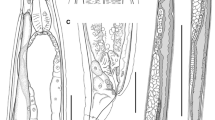Abstract
Serpentirhabdias atracti n. sp. is described based on specimens discovered in the lung of Atractus major Boulenger from Caxiuanã National Forest, Pará, Brazil. The new species is assigned to Serpentirhabdias Tkach, Kuzmin & Snyder, 2014 based on morphological characters (comparatively thin body cuticle without prominent inflations, arrangement of circumoral papillae in two lateral groups, pre-equatorial position of vulva, eggs in uteri at early cleavage stages), as well as because of its parasitism in snakes. The new species is most similar to S. vellardi (Pereira, 1928) due to the absence of lips and buccal capsule, similar body dimensions, and the specificity to dipsadid snakes in Brazil. The two species differ in the shape of the tail (bulbous dilatation in the posterior part followed by a thread-like tail tip present in S. atracti n. sp.), the width of the oesophagus, and the size of the excretory glands. Serpentirhabdias atracti n. sp. is the sixth species of this genus found in the Neotropical Region.

Similar content being viewed by others
Notes
In the original description of S. vellardi the length of the excretory glands is given as "from 0.035 to 0.040 mm" (p. 13 in Pereira, 1928); apparently, the decimal point was placed erroneously since the excretory glands shown in their figure 2 (p. 19) are longer than the oesophagus described as measuring "from 0.26 to 0.27 mm" (p. 13; Pereira, 1928).
References
Barrella, T. H., dos Santos, K. R., & da Silva, R. J. (2009). Rhabdias filicaudalis n. sp. (Nematoda: Rhabdiasidae) from the snake Spilotes pullatus (Serpentes: Colubridae) in Brazil. Journal of Helminthology, 84, 292–296.
Bérnils, R. S., & Costa, H. C. (org.) (2012). Brazilian reptiles: List of species. Version 2012.1. Sociedade Brasileira de Herpetologia. http://www.sbherpetologia.org.br/. Accessed 14 April 2014.
Kuzmin, Y. (2013). Review of Rhabdiasidae (Nematoda) from the Holarctic. Zootaxa, 3639, 1–76.
Kuzmin, Y. I., & Tkach, V. V. (2008). Rhabdias pearsoni sp. n. from keelback, Tropidonophis mairii in Australia. Vestnik Zoologii, 42, 483–488.
Kuzmin, Y., Tkach, V. V., & Brooks, D. R. (2007). Two new species of Rhabdias (Nematoda: Rhabdiasidae) from the marine toad, Bufo marinus (L.) (Lissamphibia: Anura: Bufonidae), in Central America. Journal of Parasitology, 93, 159–165.
Martínez-Salazar, E. A., & León-Règagnon, V. (2006). Rhabdias lamothei n. sp. (Nematoda: Rhabdiasidae) from Leptodeira maculata (Colubridae) in Mexico, including new records of R. fuscovenosa (Railliet, 1899) Goodey, 1924. Zootaxa, 1257, 27–48.
Martins, M., & Oliveira, M. E. (1999). Natural history of snakes in forests of the Manaus region, Central Amazonia, Brazil. Herpetological Natural History, 6, 78–150.
Myers, C. W. (2003). Rare snakes – five new species from eastern Panama: reviews of northern Atractus and southern Geophis (Colubridae: Dipsadinae). American Museum Novitates, 3391, 1–47.
Pereira, C. (1927). Fauna helminthologica de ophidios brasileiros. Boletim Biologico São Paulo, 10, 179–185.
Pereira, C. (1928). Fauna helmintologica dos ophidios brasileiros (2o). Rhabdias vellardi n. sp. Boletim Biologico São Paulo, 11, 13–22.
Santos, J. N., Melo, F. T. V., Nascimento, L. C. S., Nascimento, D. E., Giese, E. G., & Furtado, A. P. (2011). Rhabdias paraensis sp. nov.: a parasite of the lungs of Rhinella marina (Aamphibia: Bufonidae) from Brazilian Aamazonia. Memórias do Instituto Oswaldo Cruz, 106, 433–440.
Tkach, V. V., Kuzmin, Y., & Snyder, S. D. (2014). Molecular insight into systematics, host associations, life cycles and geographic distribution of the nematode family Rhabdiasidae. International Journal for Parasitology, 44, 273–284.
Yamaguti, S. (1943). Rhabdias (Ophiorhabdias) horigutii n. subg., n. sp. (Nematoda) from the lung of a Japanese snake Natrix tigrina. Annotationes Zoologicae Japonenses, 22, 8–10.
Acknowledgements
We are grateful to Gleomar Maschio, Yuri Willkens de Oliveira Costa, Laís de Nazaré Barros Barbosa, Kleiton Rodolfo Alves Silva, Lílian Cristina Macedo and Luciana de Cássia Silva do Nascimento from the Federal University of Pará for their valuable assistance during the field expedition. We are also thankful to Ana Prudente from the Museu Paraense Emílio Goeldi for identifying the host. Financial support for this study was provided by the PROPESP/PPG-BAIP/UFPA, CAPES Foundation, the Ministry of Education of Brazil (grant CAPES–PARASITOLOGIA BÁSICA/2010), and the National Council for Scientific and Technological Development (CNPq) (grants SISBiota 2010-Sistema Nacional de Pesquisa em Biodiversidade, PVE CAPES/CNPq A_033/2013).
Author information
Authors and Affiliations
Corresponding author
Rights and permissions
About this article
Cite this article
Kuzmin, Y., de Vasconcelos Melo, F.T. & dos Santos, J.N. A new species of Serpentirhabdias Tkach, Kuzmin & Snyder, 2014 (Nematoda: Rhabdiasidae) parasitic in the brown ground snake Atractus major Boulenger (Reptilia: Serpentes: Dipsadidae) in Brazil. Syst Parasitol 89, 101–106 (2014). https://doi.org/10.1007/s11230-014-9520-5
Received:
Accepted:
Published:
Issue Date:
DOI: https://doi.org/10.1007/s11230-014-9520-5



